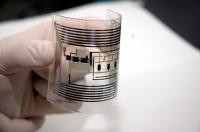Nano-based RFID tags may replace bar codes

A joint US-Korean project has come up with an inexpensive printable transmitter that, once implanted into packaging, could allow all items in a shopping trolley to be scanned simultaneously, while adjusting the total inventory of a store.
More advanced versions would collect all the information about the contents of a shop in an instant, letting a retailer know where every package is at any time. The research from Rice University in collaboration with Gyou-jin Cho at Sunchon National University in Korea appears in the journal IEEE Transactions on Electron Devices.
The technology is based on a carbon-nanotube-infused ink for ink-jet printers first developed at the US university. This ink is used to make thin-film transistors, “a key element in radio-frequency identification (RFID) tags that can be printed on paper or plastic”, said the team.
Cho, a professor of printed electronics engineering at Sunchon, said his work in the development of the electronics and the roll-to-roll printing process could “bring the cost of printing the tags down to a penny apiece and make them ubiquitous”. He predicted the technology would be available within five years.
"We are going to a society where RFID is a key player," he said.
Roll-to-roll technique
The team believes that the cost of RFID tags, which are mainly silicon based at present, could be cut dramatically by the development of paper or plastic tags printed as part of packaging. Cho said the roll-to-roll technique, which uses a gravure process rather than ink-jet printing, had the potential to replace bar codes.
James Tour, laboratory leader at Rice, said printable RFIDs are practical because their passivity and do not have a life-time limit. The tags power up when hit by radio waves at the right frequency and return the information they contain.
"If there's no power source, there's no lifetime limit. When they receive the RF signal, they emit," he said.
Hurdles to commercialisation
The researchers listed a number of hurdles that need to be overcome for commercialisation of the technology. The first was that the device must be reduced to a third of its current size to match bar code dimensions. Secondly, its transmission range has to be enlarged to around 300m - particularly to update store inventory data.
"Right now, the emitter has to be pretty close to the tags, but it's getting farther all the time,” said Tour. “The practical distance to have it ring up all the items in your shopping cart is a metre. But the ultimate would be to signal and get immediate response back from every item in your store – what's on the shelves, their dates, everything.”
He added: "At 300 metres, you're set – you have real-time information on every item in a warehouse. If something falls behind a shelf, you know about it. If a product is about to expire, you know to move it to the front – or to the bargain bin."
The quantity of the nanotubes in the packaging would be minute – at less that a pictogram per RFID tag.
“That means you can produce one trillion of them from a gram of nanotubes – a miniscule amount. Our HiPco reactor produces a gram of nanotubes an hour, and that would be enough to handle every item in every Walmart, said Tour. "In fact, more nanotubes occur naturally in the environment, so it's not even fair to say the risk is minimal. It's infinitesimal."









